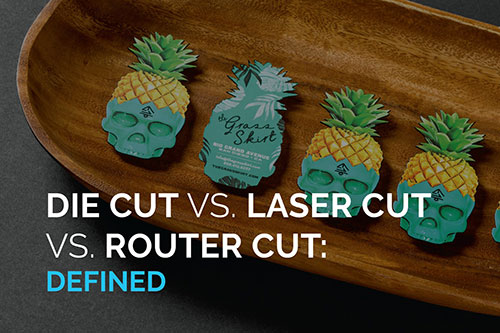Custom cut edges can make your marketing materials stand out from your competitors. When used on business cards, flyers, or coasters, a unique shape or cutaway accent upends a viewer’s expectations and catches their attention. That helps your brand get noticed.
When it comes to cutting edges, what technology is on the cutting edge? Here are the most popular choices for designers:
Die cut
Die cutting is a process where paper is cut using a metal die or blade. Traditional die cutting works like a stamp or cookie cutter, creating cutaways in the desired shape. Today, digital die cutting machines use blades to make custom shapes with more detail in shorter amounts of time—and for less money!
A die cutter can create fairly detailed cuts for a large number of prints quickly and easily. This makes it an affordable solution for custom business cards, mailers, coasters, and more. Die cut cardstock can also be double-layered to create eye-grabbing three-dimensional print materials. Die cutting turns assumptions about what defines a business card or a flyer on their head—which can help generate interest in your brand.
Die cutters can do a lot, but they aren’t great for extremely detailed cuts. Consult with a print expert at Silkcards for more details on how fine you can go.
Ideal for: Less detailed cut-paper work, multiple print runs, rounded or shaped business cards. Simple cutaways and punches. Flyers, door hangers, stickers, and other high-run print projects.
Media: Business card paper, card stock, paperboard, sticker paper, vinyl decals
Laser cut
Ideal for extremely detailed work, laser cutting is a more recent innovation that’s starting to reach the mainstream. If you’ve watched enough 007 films, it works pretty much like how you’d expect: a concentrated beam of light is focused on the paper, which is cut clean along its path (this video shows it in action). Laser cut business cards and marketing materials can be made in just about any shape, with remarkable detail in each cut. For designers, they offer unmatched creative freedom. However, each cut requires individual attention from the machine, as opposed to die cut materials which can be produced at scale. As a result, laser cut materials are usually more costly and time-consuming to produce.
Ideal for: Finely-detailed cut-paper designs on wedding invites, business cards, commercial art, and other low-run print projects.
Media: Business card paper, card stock, paperboard, sticker paper, vinyl decals
Router cut
Router cutting involves using an electric router to create larger-than-life shapes using heavy cardboard stock, plastic, and wood. Similar to routers used for carpentry, these tools are designed to give shape to large-format print projects, such as storefront signage, retail displays, trade show signs, and more.
Router cutting is a popular solution for large print projects, especially permanent and semi-permanent signage that is too large to be cut using traditional die or laser machines. Router cutting isn’t especially fine and doesn’t scale well, and as a result isn’t a workable solution for making smaller print materials like handbills or business cards. Router cutting can be budget friendly or expensive depending on the nature of your project.
Ideal for: Large format print projects, indoor/outdoor signage, graphics, window decals, etc.
Media: Foam board, vinyl, styrene, Coroplast, MDO plywood, plastic
Learn more with our Designers’ Ultimate Guide to Printing Unique, Custom Business Cards!

